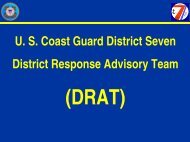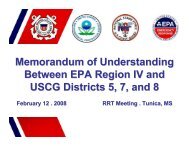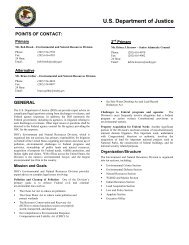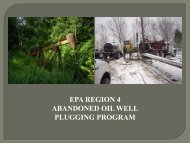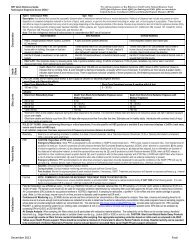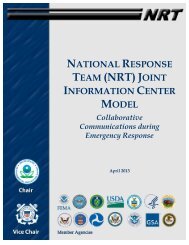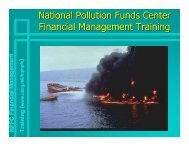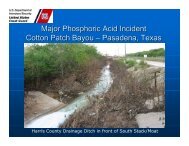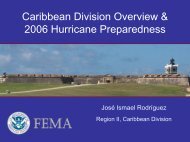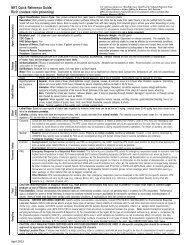USE OF DISPERSANTS - U.S. National Response Team (NRT)
USE OF DISPERSANTS - U.S. National Response Team (NRT)
USE OF DISPERSANTS - U.S. National Response Team (NRT)
- No tags were found...
Create successful ePaper yourself
Turn your PDF publications into a flip-book with our unique Google optimized e-Paper software.
high exposure levels, volatile hydrocarbons can potentially result in neurological disorders and liver damage.Effects from direct contact or ingestion of oil are generally temporary and of less concern for cetaceans. Oil isunlikely to adhere to the surface of their skin, which is also relatively impermeable to the oil's toxic components.Baleen plates of skim-feeding baleen whales may become fouled by oil on the water surface, temporarily interferingwith feeding. For a few days or weeks, hydrocarbons or their metabolites in exposed marine invertebrates could betransferred to cetaceans preying upon them. This exposure would likely be short-term and is not expected to resultin serious effects (Geraci, 1990). Benthic invertebrates accumulating residues from contaminated sediments couldprovide a potential source of longer-term exposure to bottom-feeding cetaceans. Cetaceans might also be indirectlyaffected if an oil spill resulted in destruction or significant shifts in the distribution of key prey species populations.Collision with vessels poses a serious threat to some endangered species. Right whales are particularly susceptibleto injury or death from ship collisions because they surface skim-feed and often rest at the surface. <strong>Response</strong> vesselspeeds should be restricted any time endangered species are in the area of an oil spill, especially when visibility islimited.Sea TurtlesSea turtles can be exposed to spilled oil when feeding, surfacing to breath, or nesting in areas contaminated bystranded oil. Turtles are also susceptible to floating tarballs formed from weathered oil. There is no firm evidencethat sea turtles are able to detect and avoid oil (Odell and MacMurray, 1986). Studies indicate oil exposure can haveseveral adverse effects on turtles, including toxic responses to vapor inhalation or ingestion, skin irritation,interference with osmoregulation and ion balance, and reduced hatching success (Van Fleet and Pauly, 1987; Frittsand McGehee, 1982; Lutz and Lutcavage, 1989). Experiments on adult loggerhead turtles conducted by Lutcavageet al. (1993) showed that major body systems in marine turtles are adversely affected by even short exposures toweathered South Louisiana crude oil. Effects observed included alteration of blood chemistry, alteration ofrespiration and diving patterns, interference with salt gland function, and skin lesions. Exposure to fresh oil wouldlikely be considerably more harmful. Though oil exposure may not directly kill adult turtles, the effects may makethem more vulnerable to predation or disease.Oiling of sea turtle nesting habitat poses a potential risk to adult nesting turtles, hatchlings, and to eggs. Turtleembryos are particularly sensitive. The effects of oil on the development and survival of marine turtles appears to bevariable, depending on such factors as stage of nesting, oil type, degree of oil weathering, and amount and height ofoil deposition on the beach. Studies by Fritts and McGehee (1982) indicate that fresh oil washing ashore to the levelwhere nests with incubating eggs are located may result in extensive embryo mortality. The studies found thatmortality may not be significant if eggs are deposited in sand after contamination has occurred and the oil hasweathered, although hatchlings may be smaller than normal. Some evidence suggests olfactory cues are imprintedon sea turtles as hatchlings and guide them back to their natal beaches for nesting when they reach maturity. Oil onthe beach could interfere with these chemical guides (Lutz et al., 1985). <strong>Response</strong> activities to clean oil stranded onbeaches may pose an addition risk of injury to eggs, hatchlings, and nesting adults.Analysis of Biological Effects of Proposed ActionA primary objective of an oil spill response is to quickly remove as much oil as possible from the surface of thewater, thereby minimizing direct contact with wildlife and preventing movement of the oil into nearshore andshoreline areas where removal is more difficult and environmental impacts severe. Dispersants, applied underappropriate conditions, may offer the best response option to help achieve this objective. Dispersion of oil at sea,before a slick washes ashore, reduces the overall and particularly the chronic impacts of oil on sensitive inshorehabitats including salt marshes, coral reefs, sea grasses, and mangroves. Dispersed oil is less likely than a surfaceslick to reach shoreline areas. Any dispersed oil that does move inshore is less likely to stick to shorelines andvegetation because dispersants alter the adhering property of oil droplets. Consequently, habitats recover faster ifthe oil is dispersed before it reaches them (NRC, 1989). By protecting nearshore and shoreline habitats fromcontamination, dispersant use benefits listed species and other wildlife that rely on them including sea turtles andcetaceans.Many of the species listed in the Caribbean Region rarely occur in the area where dispersant use will be preauthorizedby the Letters of Agreement and so are unlikely to be adversely affected. Most sea turtles occur primarily



